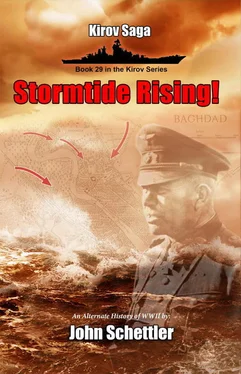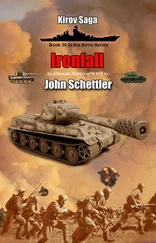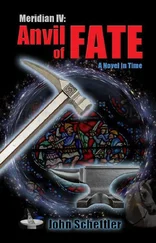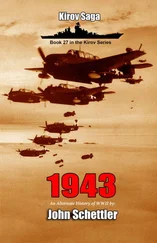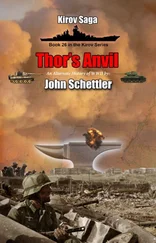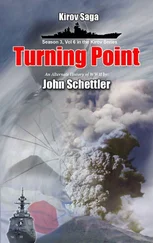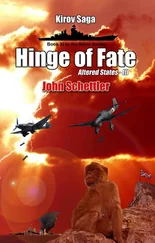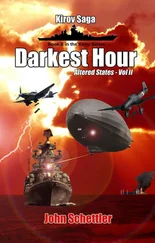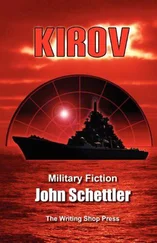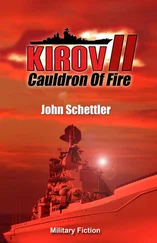“Aye sir, I’ll send down the word.”
* * *
“Con—Sonar. I think we have a course change on that destroyer.”
It was Chernov, listening as best he could on the passive hull array. “Can we slow for a better reading?”
“Very well,” said Gromyko. Mister Belanov, come to 5 knots and creep.”
“Aye sir, securing from high speed sprint, and the boat will creep on present heading at 5 knots. We remain just over the layer.”
“Good enough.”
A few minutes later, Chernov had refined his contact on the Takao , but still had no other contacts. “I was right sir,” he said. “ Takao has turned on a new heading of 270, and reduced speed to 28 knots. The range is now 23 nautical miles.”
“Interesting,” said Gromyko. “The boat will come to 270.”
“Aye sir, coming around to 270.”
“Keep listening Chernov….”
He did.
At 22:14 the hull array sonar detected a new contact, just after Gromyko stopped after a sprint of nearly 1 hour. He wanted Chernov to refresh his fix on Takao , but what he got instead was a hot new contact, almost dead ahead, but at a range of 37 nautical miles.
“What about Takao?”
“Still listening, sir, but nothing yet.”
Gromyko did not like the sound of that. Chernov should have that bastard, and they should be very close. The nearest bear in the water was at 272, the range now refined to 36 nautical miles, speed 20.
But Takao was gone.
“What’s happening, Chernov?” This was a question the Captain needed answered quickly.
“Sir,” said Chernov. “Assuming they were on the same bearing as before, they would now be masked by the Mokil Atoll—right in the shadow, sir. It’s the only way they could drop into oblivion like that.”
“Very well.” The Captain pulled Belanov aside. “What do you make of this latest contact?”
“Could be anything,” said Belanov.
“Yet it’s running at 270, just like Takao . I think it may be what I’ve been looking for.”
“That enemy carrier?”
“Something launched those fighters at Kirov . It wasn’t Takao . I make that ship to be an escort picket.”
“Latest message from Kirov indicates the three destroyers that were shadowing them turned on a new heading and broke off.”
“What heading?” Gromyko scratched the back of his neck.
“The last we had was 352, then they lost them. They went dark.”
The Matador nodded knowingly, his eye playing over the chart. “Momma Bear has called home her cubs,” he said with a thin grin. That course would bring them right up here, right across our present heading, and that of that new contact out there.”
“Sure sounds like we have something here.”
“That it does. Mister Belanov—go wake the Admiral.”
Nothing firmed up on the sonar, so Gromyko made another 15 minute sprint before slowing to creep speed again, just 5 knots. Then his day got a little more complicated.
“Con—Sonar. I have two new contacts both on identical headings. The leading contact is bearing 290, range 36 nautical miles. The shadow is trailing it here,” he pointed to his screen, “about 15 nautical miles behind.”
This wasn’t adding up. Neither contact could have been the Momma Bear Gromyko was gunning for a half hour earlier. They were just too far north, so they had to be something new. But what?
“This is a lot of traffic for a big empty ocean like this,” said Admiral Volsky. “You say you had a destroyer bearing southwest, a second contact due west, and now two more, north by northwest? I agree that they may be trying to make a rendezvous, but you are now possibly running into many overlapping sonar spheres. I am told this boat is very stealthy, but how good is our enemy?”
“Sir,” said Chernov. “There’s a lot of mixed surface cavitation off on 270. I think Takao and the other contact are still out there, and these new bears are latecomers to the den.”
“Thank you, Mister Chernov.”
Gromyko looked at the Admiral. “The question is whether to attack or not? We don’t have a firm reading on either of these two new contacts. For all we know, they could be IJN traffic from this era. Nor do we know whether or not any of those other ships have gotten a whiff of us yet. I think Chernov is correct, the main body is off on 270, but we would be putting ordnance on a blind target if I attack these other two, and giving away our position at the same time.”
“Agreed,” said Volsky. “Save your missiles, Mister Gromyko. See to the safety of the boat first. This is going to be a very long war, and at the moment, I do not even see a reading for Kirov on that screen. Where has our Mister Karpov gone?”
Gromyko had just found a very important target. The lead contact was the helicopter destroyer Kurama , and it was being followed by fat Omi , the fleet replenishment ship. They were, indeed, the last two bear cubs heading for Admiral Kita’s den, but Gromyko did not know that yet. All he could fire at was an assumption, and that had not been good enough for Volsky.
As for Kirov , when the three foxes in pursuit broke off, Karpov was elated. He ordered the ship to alter course, then went EMCON, hoping there were not already more stealth fighters inbound on his position. Round one of this strange new duel at sea was over, but the long grueling hunt for Kirov by a newly emboldened Imperial Japanese Navy was only just beginning.
* * *
AdmiralRaeder stepped onto the bridge of the Prinz Heinrich , watching the ships ahead of him ease out of the harbor through heavy night fog. He still had grave misgivings about this undertaking, and he could feel that in his elevated pulse as the fleet departed. It was not that he felt his men and ships were unequal to the task ahead. No. He had every confidence in them.
He would lead the task force aboard Prinz Heinrich , this time rigged out as a full fighting carrier, laden with 27 Stukas and 13 Me-109s. The Goeben under Falkenrath would bring another 12 planes to sea, giving him 52 aircraft at his disposal when he was far from land based air power. For battle at sea, he knew he would be unmatched. He was taking the best he had left in the Med, the Bismarck under Lindemann, the Kaiser Wilhelm under its able Kapitan Werner Heinrich, and the fearsome French built heavy battleship Normandie , now fully crewed by survivors from the Hindenburg , and renamed Friedrich de Gross. He gave that ship to Kapitan Helmuth Brinkmann, who trained the new crew for these last two months in the waters off Toulon.
To escort all these ships, he needed destroyers, and he had three of the new German built SPK Beowulf class ships , Odin, Agir and Thor . They were fast at 38 knots, each with 12 dual purpose 4.7-inch guns, and six torpedoes. To these he would add as many of the French destroyers as could be spared from the supply run duties to Tunisia—only three. Yet he selected the best they had, the Fantasque class ships, again renamed and fully re-crewed by sailors sent from Germany. It had been necessary to completely de-crew the remains of the French Navy and send all those experienced sailors home. Now any ships that could be kept serviceable were being crewed by sailors from Germany and Italy, and others impressed from the Balkans. The three French ships were renamed for ships listed in his building program that would now most likely never be realized. They would be dubbed Hildr, Sigrun, and Mist .
Two battleships, the carriers, a fast battlecruiser, and six destroyers, thought Raeder. I could use six more destroyers, but they cannot be spared. Yet the Italians have promised me support from their fleet. I will pick up Maestrale, Alpino and Ascari when we enter the Tyrrhenian Sea. There will also be three superb fast light cruisers, Regolo, Mario and Silla . This is a fleet that can confidently meet any other at sea, well balanced, very fast, with far ranging strike power in the carriers, and the murderous fire of those heavy guns up close.
Читать дальше
